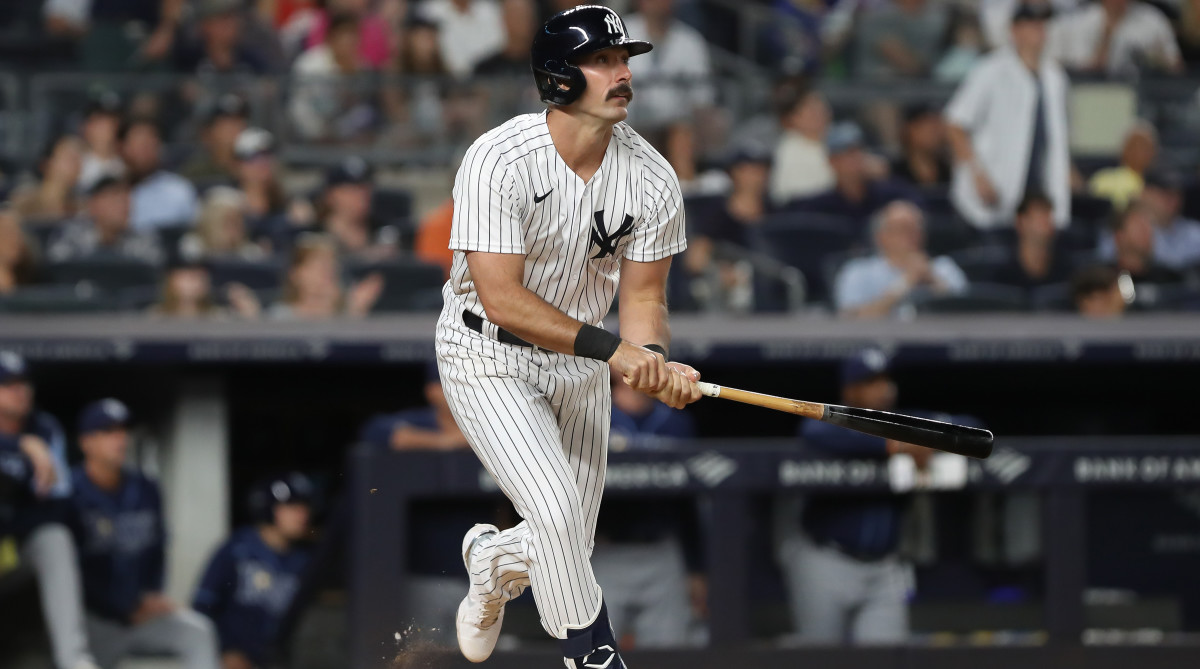‘I’m About to Get Hot’: Inside Matt Carpenter’s Revival With the Yankees
Welcome to The Opener, where every weekday morning during the regular season you’ll get a fresh, topical story to start your day from one of SI.com’s MLB writers.
NEW YORK — A month before he became a multiposition sensation for the Yankees, Matt Carpenter planned his retirement tour. He had told himself before the season began that if after a month with the Rangers’ Triple A affiliate, the Round Rock Express, he had not been promoted to the major leagues, he would go home and spend time with his wife, Mackenzie, and their two young children.
Six weeks in, Carpenter, 36, realized no call-up was imminent. So he began saying goodbye to the only job he’d ever wanted, soaking in every moment between the lines. He invited his longtime agent, Bryan Cahill, to one of his last home games. Carpenter asked his parents, Mackenzie and the kids to come to his final series, in Sugar Land, Texas.
On May 19, he requested his release, and he drove home to Fort Worth, where he parked himself on his couch. Cahill emailed about half the league, letting them know his client was available, but Carpenter had made peace with an unceremonious end to an 11-year career in which he made three All-Star teams, won a Silver Slugger at second base and four times received MVP votes.
Two months later Carpenter sits in the Yankees’ dugout and cocks his head. “The thing that’s so confusing to me,” he says, “is that nobody responded [except] the best team in baseball.”
That’s not quite right: A few teams, including Atlanta and the Red Sox, reached out but could only offer spots in Triple A, and Carpenter had already decided he “wasn’t just gonna put my family on the back burner to play minor league baseball,” he says. Still, New York was the only team that was prepared to add him to the major league roster immediately.

The others surely wish they had found room: Since Carpenter joined the Yankees on May 26, he has a .451 on-base percentage and an .868 slugging percentage. He has hit 11 home runs in 68 at bats. Asked what New York is doing to put Carpenter in position to succeed, manager Aaron Boone laughs. “Send him up to hit,” he says. “He’s doing a lot of succeeding that way.”
This would have been unimaginable a year ago, when Carpenter was slogging through his second straight season with a batting average in the .100s. His career had always seemed somewhat miraculous: The fifth-year senior at Texas Christian whom the Cardinals took in the 13th round of the 2009 draft and signed for $1,000 had made himself a star on a perennial contender. But he had always been a “feel” hitter, and by ’20, he had completely lost his feel for his swing.
So in October, after St. Louis declined his $18.5 million option and made him a free agent, he called Reds first baseman Joey Votto, a longtime opponent and hitting expert. Votto was on vacation in Paris and was not expecting the call—the two had never had a longer conversation than chatter at first base—but he had been following Carpenter’s dropoff, and he had some thoughts.
“You watch someone that you’re used to seeing performing at a level, then you watch them perform at a different level, and you observe it and you’re like, ‘Come on! You can do it!’” Votto says. They spoke for some 45 minutes about how Carpenter could generate more force, using lessons Votto had gleaned from speaking with a golf pro after his own precipitous decline in 2019 and ’20.
Relieved that perhaps the smartest player in the game thought he had something left, Carpenter dedicated himself to remaking his swing. Over the next five months, he crisscrossed the country, from a hitting lab in Baton Rouge, La., to a hitting instructor in Santa Clarita, Calif., to a college team in Stillwater, Okla., a journey The Athletic’s Ken Rosenthal detailed this winter.
Carpenter felt sure he had found something, but teams were skeptical, and the best he could do was a minor league deal with Texas, whose Triple A affiliate played three hours from his Fort Worth home. As a nonroster player, he got limited at bats in spring training, but on April 10, he texted Cahill, “I think I found it today. Here’s my call. … I’m about to get hot.” A week later, Carpenter walloped a home run at 107 mph, his hardest-hit dinger in three years. “Things are clicking,” he texted Cahill. Over the next 15 games, he had a .776 slugging percentage.
“He’s taking more chances,” says Votto, who has not spoken with Carpenter since their call but has followed his season. “I felt like at times [in the past] he was satisfied with a walk or a tough at bat: That was a tough at bat; I saw a lot of pitches. I don’t want to mind-read, but I’m just sharing what I saw as a third party. Whereas now he seems more reckless. Good hitters are reckless.” (Carpenter says he agrees with this evaluation.)
But there was no opening on the major league club. The Rangers had newly acquired Mitch Garver at DH and Nathaniel Lowe, a former top prospect, at first base, the two positions they saw Carpenter manning, and they had to that point been among the healthiest teams in baseball. At the time, the league was planning to mandate teams carry no more than 13 pitchers starting May 30. (In the end, the league extended the deadline to June 20.) Practically, that meant most teams would have to call up a position player.
Carpenter called Rangers GM Chris Young. “Is it going to be me?” he asked.
Young told him the team hoped to find room for him at some point, but he would not be the first call-up. “In hindsight we underestimated how well [Carpenter’s Triple A production] would translate to the big leagues,” Rangers president Jon Daniels says in a text message. “We try to be open with all our players and especially so with someone with Matt’s experience and character. We let him know he wasn’t in our short-term plans.”
Carpenter felt Texas had done right by him—keeping him out of the lineup the day before an off-day whenever possible and telling him to spend 48 hours with his family instead of reporting to the ballpark, for example—but he was not interested in toiling in the minors, waiting for someone to get hurt. He requested his release, said his farewells to the sport and went home. And then Yankees assistant GM Mike Fishman called.
“Obviously it’s not really a comparable thing, but people who lie on their deathbed wishing they hadn’t taken things for granted—you get a second chance at life,” Carpenter says. “I mean, that’s basically what happened with me and my baseball career. I got a second chance. And every day, the most mundane things that most people get tired of I look forward to, like coming out to the field for BP, taking ground balls.” The day he arrived, he told Boone he would help unload bags from the plane if that’s what the team needed. “I was pretty serious,” Carpenter says.
That was not quite what the team had in mind for him. The Yankees had long coveted Carpenter, dreaming of his powerful lefthanded swing lining balls into the short right field porch. They had followed his swing change, and they were the only team to reach out to Cahill before his email landed. So when Carpenter joined New York, hitting coach Dillon Lawson was ready with a statistic. “Hey, remember that year you hit 36 home runs?” he said, referring to 2018. “Do you know how many you would have hit at Yankee Stadium?”
“How many?”
“Fifty-two.”
Carpenter gaped. “No way!”
Lawson grinned. “We’re missing a little bit of time,” he said, “But how about we go for 40?”
Only one team was interested. It turned out to be the perfect one.
Watch Carpenter and the Yankees all season long with fuboTV: Start a trial today!
More Baseball Coverage
• ‘A League of Their Own’ Endures Because It’s Personal
• Unvaccinated Royals Lay Bare Their Lack of Commitment
• The Rays Are Falling Apart
• American League MVP Race Is on a Historic Track
• MLB Power Rankings: Biggest All-Star Snub on Each Team
